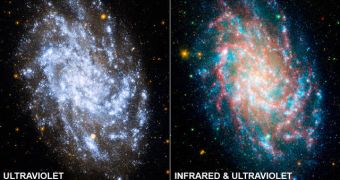The GALEX (Galaxy Evolution Explorer) mission, launched on April 28, 2003, has just turned six years old on the job, mission controllers at NASA rejoice. Located on a nearly circular orbit around the planet, at a height of about 697 kilometers (432 miles), and an inclination of 29 degrees to the Equator, the observatory surveys thousands of galaxies in the near- and far-ultraviolet spectrum, at wavelengths between 135 and 280 nanometers. It's able to detect and analyze the formation of stars dating back to approximately 80 percent of the age of the Universe, which makes it an invaluable and unique tool in the American space agency's telescope arsenal.
“NASA's Galaxy Evolution Explorer Mission marks its sixth anniversary studying galaxies beyond our Milky Way through its sensitive ultraviolet telescope, the only such far-ultraviolet detector in space. The mission studies the shape, brightness, size and distance of galaxies across 10 billion years of cosmic history, giving scientists a wealth of data to help us better understand the origins of the Universe,” a press release on California Institute of Technology's (Caltech) website says.
A landmark image sent back by the GALEX observatory is that of the M33 galaxy. The left of the two pictures shows the results of the ultraviolet survey that the observatory carried out on the star aggregate. All of the details were resolved using only the instruments aboard the telescope. In the right-hand image, a layer of infrared readings was superimposed on the photograph. The latter data was collected by the Spitzer Space Telescope, which operates in infrared wavelengths. M33 is located just 2.9 million light-years away, in the Triangulum constellation, and is considered to be one of our closest neighbors.
“Since its launch from a Pegasus rocket on April 28, 2003, the Galaxy Evolution Explorer has imaged more than a half-billion objects across two-thirds of the sky. Highlights over the past six years include detecting star formation in unexpected regions of the universe and spotting Mira, a fast-moving older star called a red giant. Astronomers say that studying Mira's gargantuan cosmic tail is helping us learn how stars like our sun die and ultimately seed new solar systems,” the press release adds.

 14 DAY TRIAL //
14 DAY TRIAL // 
